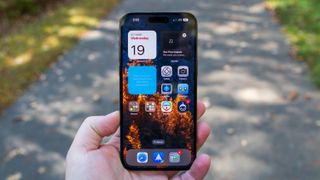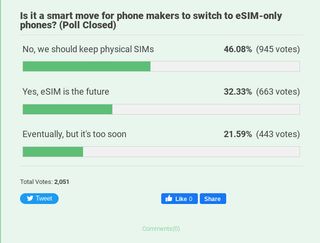The world isn't ready for eSIM-only phones
Keep the physical SIM for now.

What you need to know
- Apple released the iPhone 14 with an eSIM-only model for the United States.
- We asked our readers if more OEMs should invest in eSIM-only smartphones.
- Of more than 2,000 votes, 46% say we should stick to physical SIM cards.
Support for eSIM is growing among Android devices, particularly as Apple starts investing in eSIM-only models for its latest iPhone 14 series. While OEMs and carriers tout the benefits of eSIM technology, it appears the world may not be ready for the move to eSIM-only devices, as highlighted by Android Central's Andrew Myrick and his recent experience.
We recently asked our readers if they think more OEMs should make eSIM-only smartphones. We received 2,051 votes, out of which 46% say that we should stick to physical SIM cards. However, 32% agree that eSIM is the future and that OEMs should make eSIM-only smartphones. Lastly, 21% are somewhere in the middle, saying that it's too soon for these types of smartphones.

Even though easier travel is one of the benefits U.S. carriers and OEMs like to tout when it comes to eSIM, one reader, David Chow, says it actually makes it more difficult"
"Because not all operators, especially MVNOs offer eSIM as part of their proposition. Also makes getting a local SIM if you don't have global roaming included in your plan a much more painful process when traveling!"
Forrest Armstrong also points out the ease of use when using physical SIMs and isn't opposed to phones still supporting both for the time being:
"I'm cool with supporting a max of 2 SIMs be it a mix or match of physical and or eSIM, but it's nice especially if you are traveling to be able to swap a physical SIM if you so choose."
Another reader, Mike Ferrante, had a similarly troublesome experience as Android Central's Andrew Myrick when trying to move between a physical SIM to an eSIM:
Be an expert in 5 minutes
Get the latest news from Android Central, your trusted companion in the world of Android
"No, I have an iPhone 14 Plus and wanted to try out a Samsung Galaxy S22 Ultra and it was an absolute nightmare to switch and even worse when I wanted to switch back to my iPhone."
In response to Ferrante, a reader points out that the experience is fairly easy with T-Mobile, although it seems Xfinity Mobile (an MVNO) doesn't make it so easy, which highlights how not every carrier is ready for the technology, even in the United States, where the iPhone 14 series is eSIM only.
Android Central's Jerry Hildenbrand thinks that Apple jumped the gun when moving to eSIM-only with devices like the iPhone 14 Pro Max. It's something Motorola tried with the Razr reboot but quickly abandoned with the 5G follow-up. However, he points out that ease of use is not the primary focus of eSIM — it's security.
"An eSIM makes it more difficult for someone to get control of your phone number because there is more carrier involvement. That's also inconvenient, as plenty of carriers that offer an eSIM option force you to visit a store."
So while the eSIM experience may be cumbersome for now, the security benefits and growing support among the best Android phones will hopefully force carriers and OEMs to streamline things a bit more. Until then, we should keep physical SIM cards around for a while.

Derrek is a long-time Nokia and LG fanboy who loves astronomy, videography, and sci-fi movies. When he's not working, he's most likely working out or smoldering at the camera.
